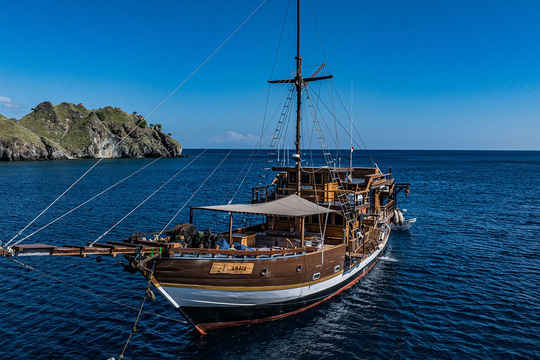Marine life in Indonesia
Marine life in Indonesia is a mix of both Asian and Australasian species that are separated by the "Wallace Line". Both species live in very close proximity, but their separation is notably abrupt. The separation lies within Lombok Strait, between the Islands of Bali and Lombok.
Indonesia is part of the coral triangle, an area known to hold the highest marine species diversity in the world. While scuba diving in Indonesia, you will have the chance to see over 3000 species of fish and over 600 species of coral. It is almost an incomprehensible statistic, but in Raja Ampat, nearly 300 fish species were recorded on a single dive.
Throughout most dive sites in Indonesia, it is possible to see 5 of the 7 species of sea turtle, including the hawksbill, leatherback, olive Ridley, loggerhead and green sea turtle. The best dive sites are frequently visited by some very large pelagic species, including whale sharks, hammerheads, ocean sunfish (also known as Mola mola), manta rays, oceanic whitetip and blacktip reef sharks, eagle rays, barracuda and even dolphins.
Indonesia is also growing in reputation as a world-class muck diving destination. With such densely populated sites, like Lembeh Strait and Ambon Harbour, it's not hard to see why. Macro photographers will be able to capture many of their desired species including harlequin shrimp, the psychedelic frogfish, pink rhinopias, countless species of nudibranchs, mandarin fish and dragonets.
Best dive sites in Indonesia
Komodo is a relatively small island, but it is also one of the most prolific. Over 1000 fish species swim in Komodo National Park, and it also happens to be one of only seven places in the world with pink sand on its beaches. Strong nutrient-carrying currents support a high diversity of species, including, manta rays, pygmy seahorses, dolphins, and the blue ringed octopus.
Raja Ampat is a scuba dive hotspot in Indonesia and currently believed to hold the richest marine environment in the world. Located just off the northwest tip of New Guinea, there have been recorded over 1500 species of fish, 537 corals, and nearly 700 mollusc species. Very high numbers of manta rays visit and Raja Ampat is one of the few locations where you can go scuba diving inshore to see the lakes of "unpoisoned jellyfish".
Lombok lies just beside the 'Wallace Line' providing easy access to see both Asian and Australasian species. It is also within close reach to Tulamben Bay, Bali, where the wreck of USAT Liberty rests. The wreck is now entirely encrusted with soft corals and large gorgonian fans, as well as being a great site to see oceanic whitetip and blacktip reef sharks.
Cenderawasih Bay is a very sheltered location that attracts incredibly high numbers of whale shark. It also serves as a fantastic site to go scuba diving when conditions elsewhere in Indonesia are rough. The mangrove ecosystems that line the shores are perfect breeding grounds for many species, offering good protection. If you are lucky, you have a chance of seeing dugongs and even the mighty blue whale!
Halmahera is the largest island of the Moluccas, presenting vibrant coral gardens in the shallows, prominent volcanic formations, drift and walls dives, as well as muck sites. This is a relatively unexplored area of Indonesia and promises many more sites to be discovered. Halmahera is a great place to go scuba diving with hammerhead sharks and holds a very impressive 686 species of fish and 450 species of coral.
Indonesia diving season
Lying on the equator, Indonesia has a very distinct wet and dry season. The best time to go on a dive trip to Indonesia is during the dry season when the weather is at its calmest. Indonesia is such a big country, that the timeframe for each season changes slightly depending on location. However, very generally, dry season is from June until October, and wet season from November until March. It is possible to go scuba diving in Indonesia throughout the entire year in certain locations, so long as it is permissible under the rules of the Marine National Park in that area. Dive sites like Cenderawasih Bay offer more shelter and is more frequently visited during July and September when strong trade winds create rougher conditions in many other dive spots.
Experience level for diving Indonesia
Indonesia scuba diving has something for all experience levels. The Gili Islands just off Lombok are an ideal location to learn to dive in, with gentle currents and a fairly sheltered position.
Many sites in Indonesia do require an intermediate or advanced level diver and this is usually due to strong currents. Komodo is known for having very fast currents, while the currents around the island of Nusa Penida can also be unpredictable, shifting direction mid-dive.
How do I get to Indonesia
Indonesian liveaboards that will take you scuba diving are relatively straight forward to reach. Although direct international flights are available to several of Indonesia's airports, the majority do not cater for long-haul flights, especially from Europe. It will be necessary to make a connecting flight, preferably via Singapore if possible. All the major airports in Indonesia are available directly from Singapore, greatly reducing any logistical headaches.
Following your flight to Singapore, there are 4 main airports in Indonesia one typically flies to. The specific airport chosen will depend on the departure location of your dive trip, and some dive cruises set sail from such remote ports that an additional flight may be required. The 4 main airports are located in Jakarta, Manado, Bali and Lombok.

















